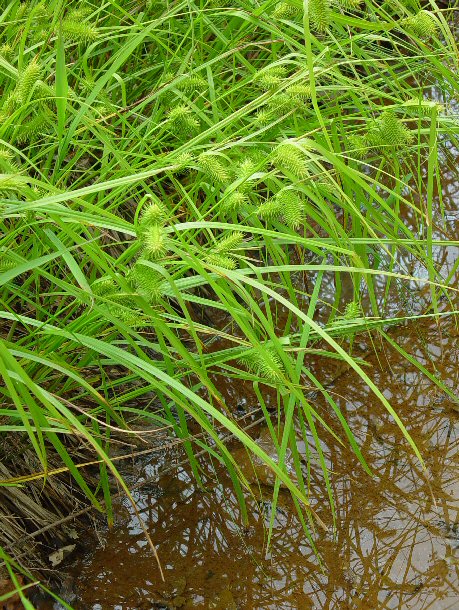Carex lurida Wahlenb.
Sallow Sedge

Native
CC = 6
CW = -5
MOC = 60
© DETenaglia
Carex lurida Wahlenb.Sallow Sedge | |
 |
Native CC = 6 CW = -5 MOC = 60 |
© DETenaglia |
|
Family - Cyperaceae Habit - Sedge with short rhizomes, forming dense clumps. Stems - Flowering stems 15-100 cm long, bluntly trigonous, tinged reddish purple at the base.
Leaves - Lowermost leaves reduced to nearly bladeless sheaths. Leaf blades 10-50 cm long, 4-9 mm wide, dull green to yellowish green. Leaf sheaths concave or truncate at the tip, the ligule longer than wide and V-shaped.
Spikes - Terminal spike staminate, 10-80 mm long, the scales 4.5-13.5 mm long, oblanceolate, hairy along the margins, the tip tapered abruptly to a noticeable awn with roughened or toothed margins, yellowish brown with a lighter midrib and margins. Lateral spikes 1-4, 10-70 mm long, 14-22 mm wide, all pistillate, narrowly oblong to nearly circular in outline , more or less rounded at both ends, the lowermost spikes with short to long stalks, erect or ascending, rarely nodding or drooping, the lowermost bract usually lacking a sheath or nearly so. Pistillate scales 3.5-12.0 mm long, the short, main body oblong, the tip tapered abruptly to a long awn 1-3 times as long as the body with roughened or toothed margins, yellowish brown with a green or tan midrib and lighter margins.
Perigynia - Perigynia 6-10 mm long, 2-4 mm wide, ascending to spreading at maturity, ovate in outline, tapered gradually to a beak with erect to somewhat spreading teeth 0.4-1.0 mm long, inflated and circular or nearly so in cross-section, the surface papery, with 7-12 nerves, olive green to straw-colored. Styles contorted (abruptly bent, curved, or looped) in the lower half. Fruits - Achenes with the main body 1.8-2.5 mm long, elliptic-obovate in outline, yellowish brown, minutely roughened.
Flowering - May - September. Habitat - Bottomland prairies, streambanks, pond margins, marshes, fens, wet open places. Origin - Native to the U.S. Lookalikes - Other sedges, particularly C. frankii. Other info. - This common species can be probably be found in every Missouri county south of the Missouri River, less commonly in the northern half of the state. Its larger range includes the entire eastern half of the continental U.S. It is very common in fens and along roadside ditches near low prairies and marshes. Important characters for identification include the large perigynia which are gradually tapered to long beaks having two tiny teeth at the apex, and pistillate scales with awns longer than the main body of the perigynium. The fruits have persistent styles which are strongly contorted near the base. The lookalike C. frankii has perigynia which are abruptly narrowed to the beak instead of being long tapered. Photographs taken at the Peck Ranch Wildlife Refuge, Carter County, MO., 6-13-03 (DETenaglia); also at Kaintuck Hollow fen, Phelps County, MO, 6-3-2021 (SRTurner). |